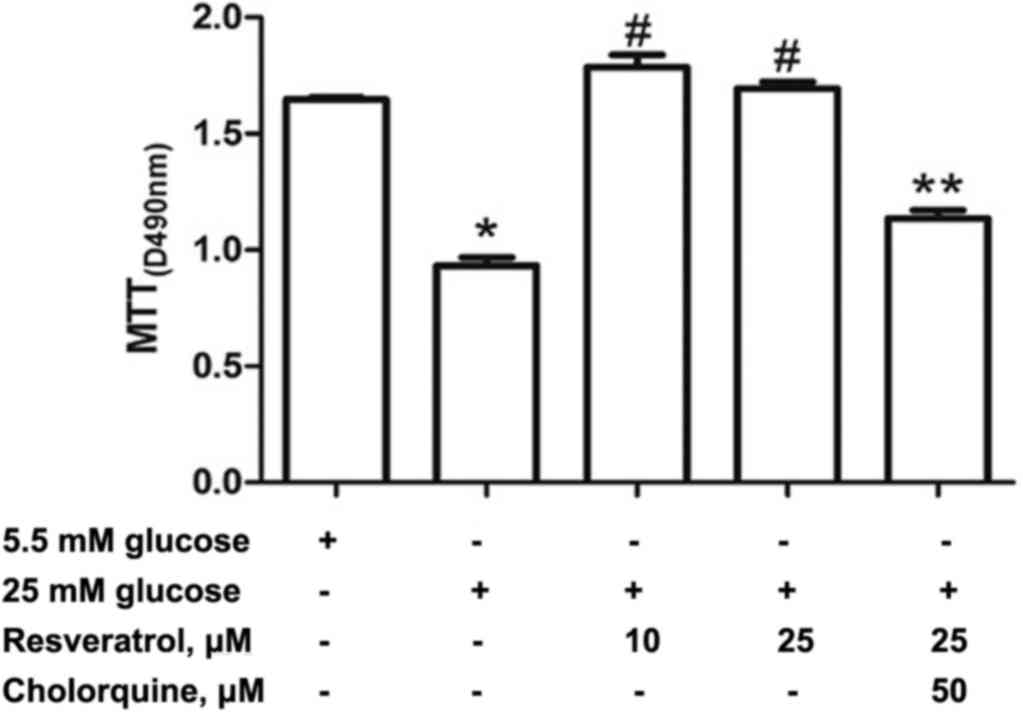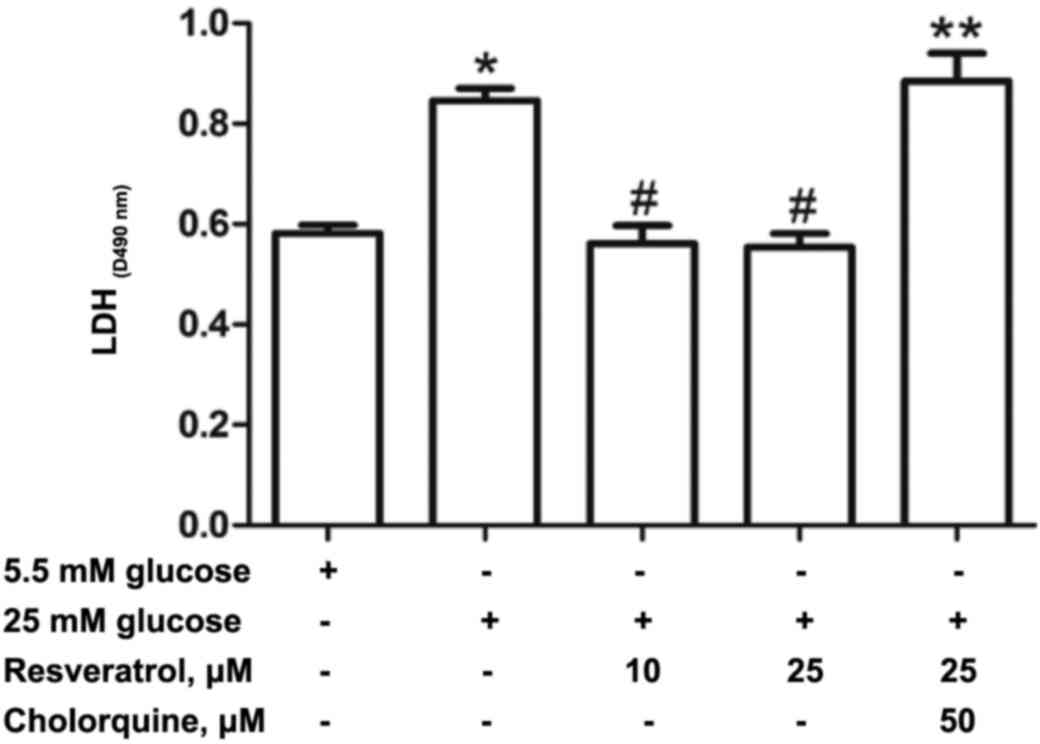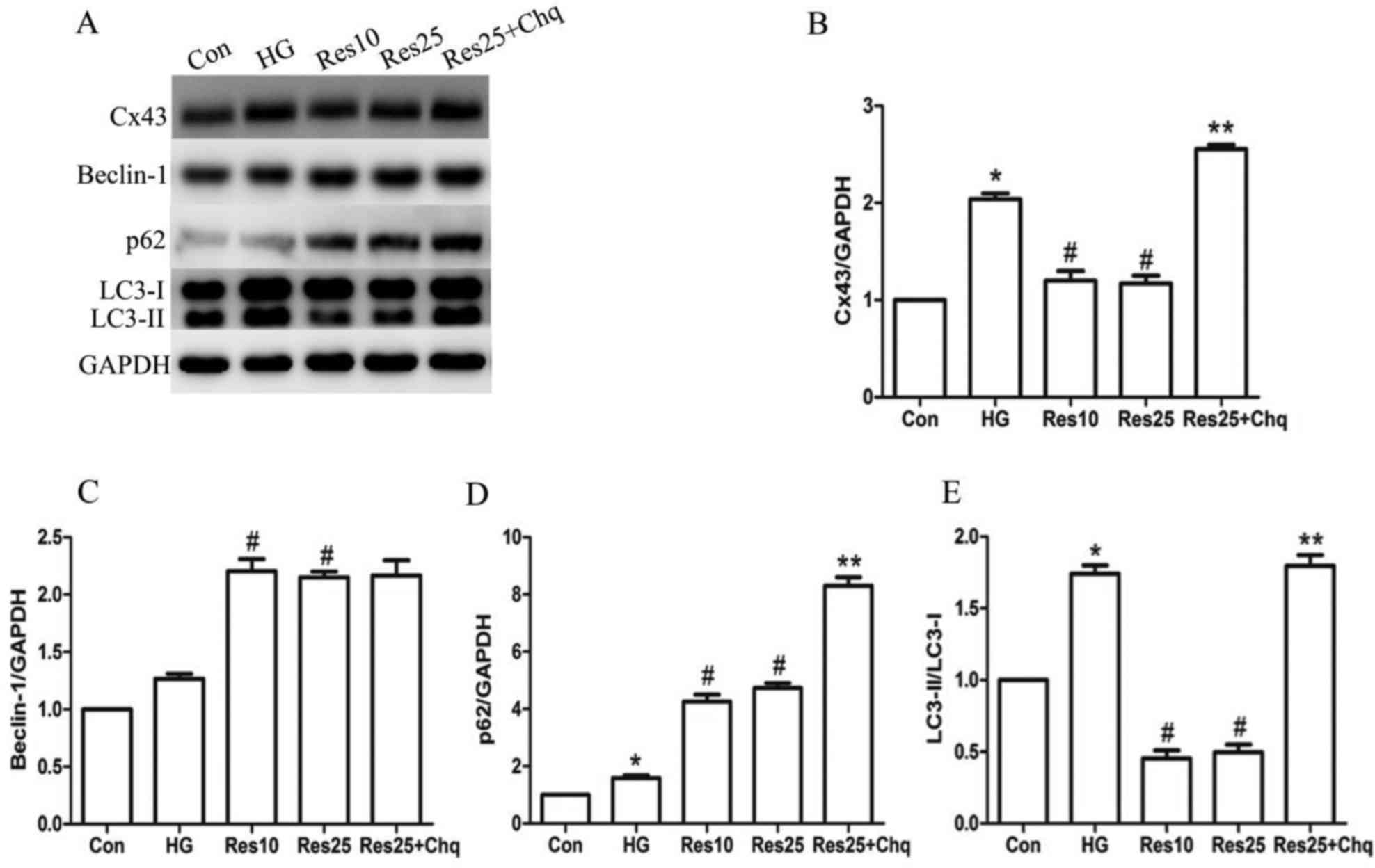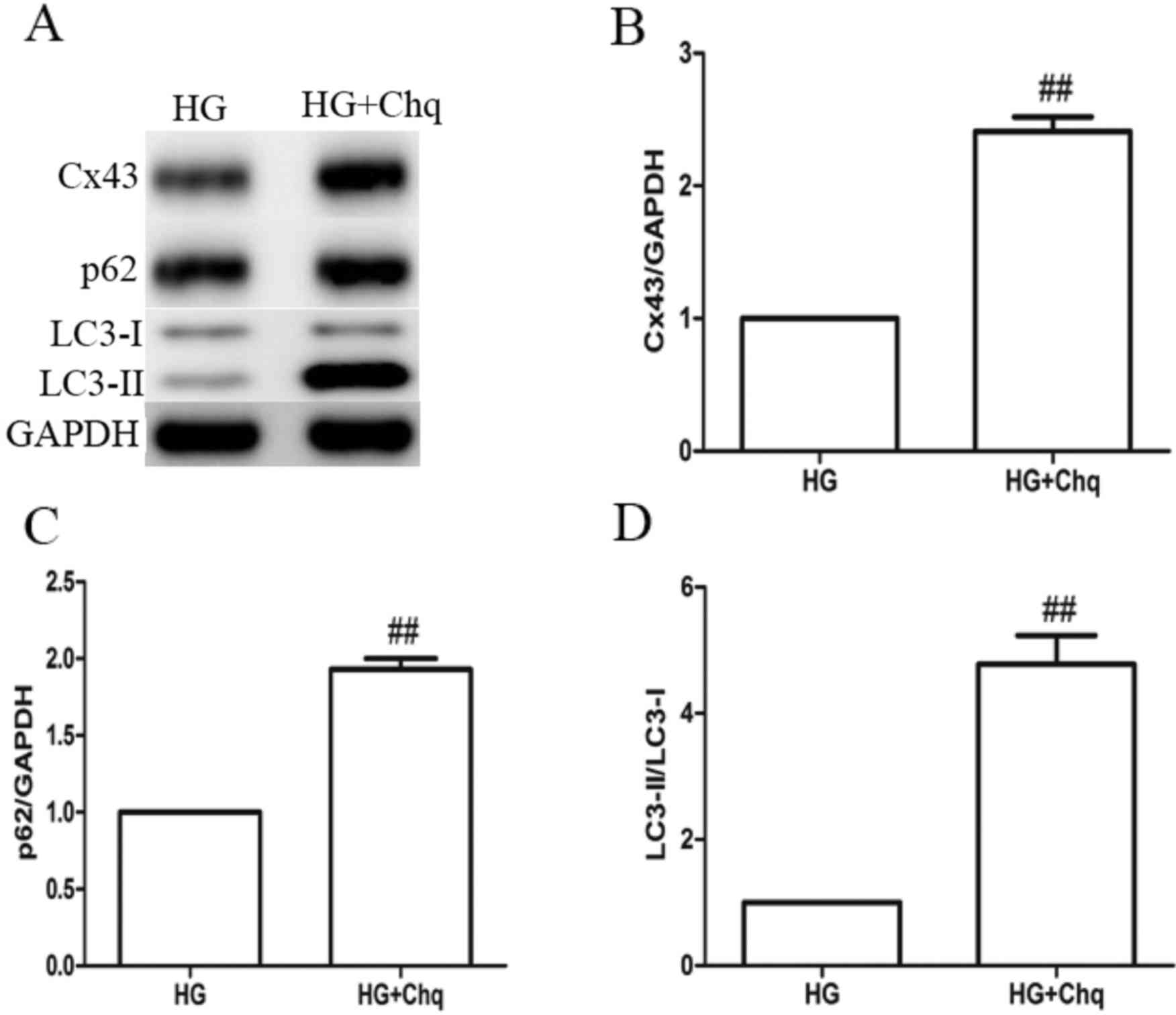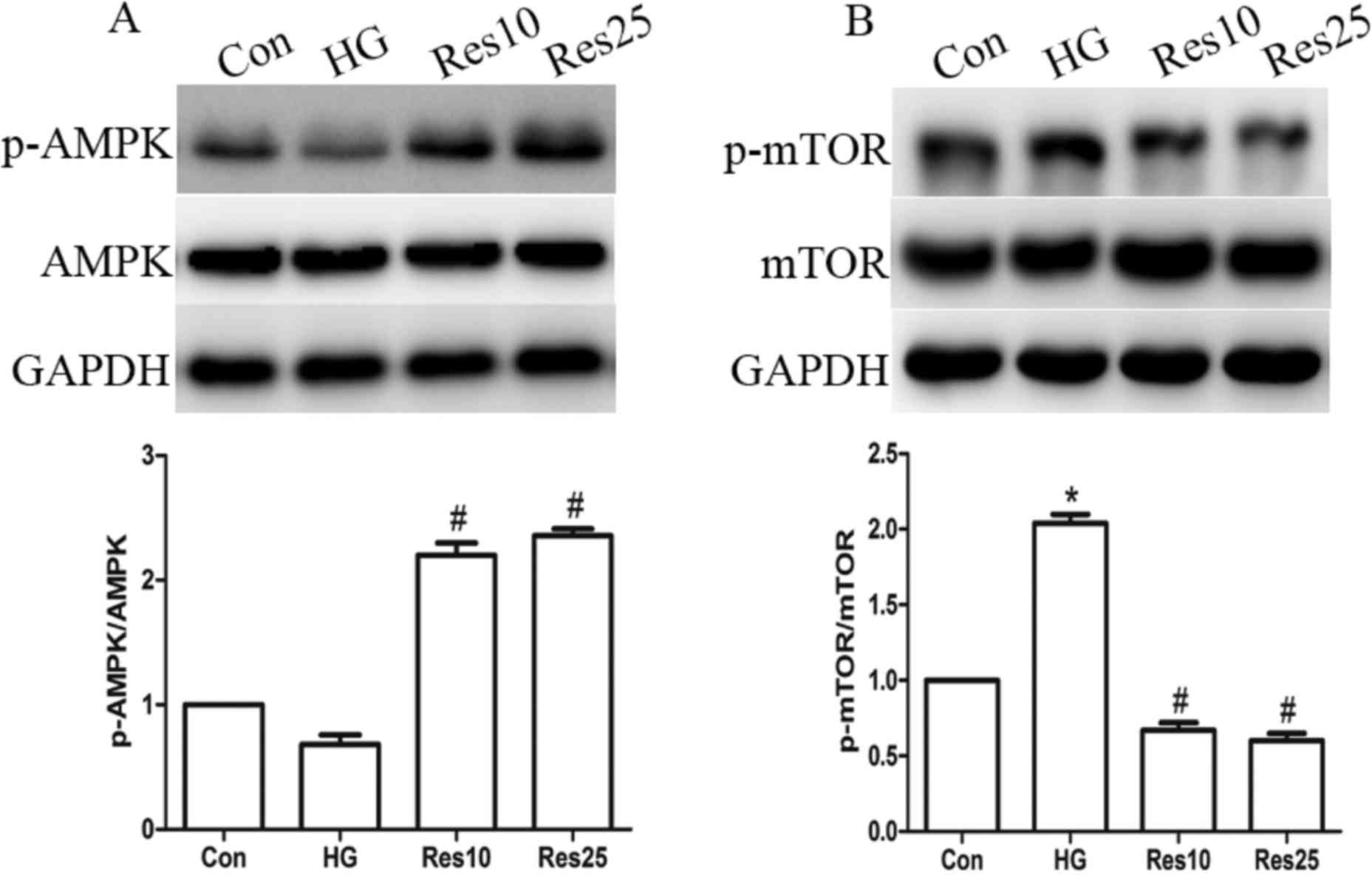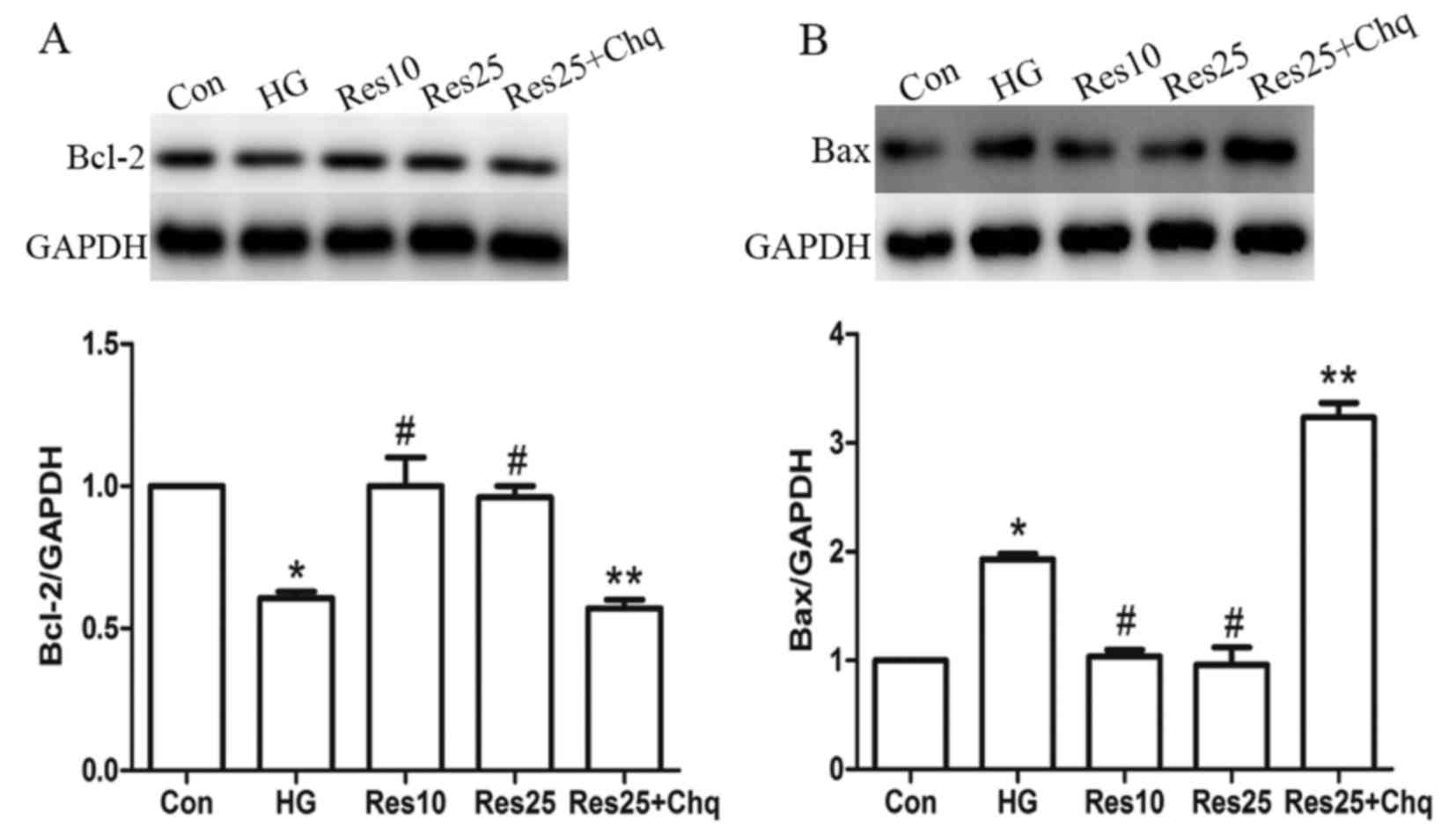Upregulation of connexin 43 and apoptosis‑associated protein expression by high glucose in H9c2 cells was improved by resveratrol via the autophagy signaling pathway
- Authors:
- Published online on: July 12, 2017 https://doi.org/10.3892/mmr.2017.6953
- Pages: 3262-3268
-
Copyright: © Wang et al. This is an open access article distributed under the terms of Creative Commons Attribution License.
Abstract
Introduction
Apoptosis is involved in a series of cardiovascular ailments, including diabetic cardiomyocytes. Previous studies have identified a higher rate of apoptosis in diabetic hearts in vivo and in vitro (1,2). However, the underlying mechanisms of pathogenesis remain to be elucidated.
In order to effectively pump blood, the heart relies on gap junctions (GJ), which allow for the rapid propagation of the electrical impulse to all cardiomyocytes (3). Apart from the transmission of electrical signals, GJ also mediate the exchange of ions, nutrients and small molecules between adjacent cells (4). GJ consist of a transmembrane protein, termed connexin (Cx). Connexin 43 (Cx43) belongs to the Cx family and is the primary connexin in ventricular cardiomyocytes (5). Previous studies revealed that the abundance of Cx43 is altered during various cardiovascular diseases, such as arrhythmia (6), myocardial infarction (7), heart failure (8) and hypertension (9). Furthermore, previous studies suggested that Cx43 expression was also altered in hyperglycemic conditions (10–12). However, there is controversy on the expression of cardiac Cx43 in diabetic rats or cardiomyocytes exposed to hyperglycemic medium, which indicated that Cx43 may be strongly related with the dysfunction of the diabetic rat heart. Previous studies demonstrated that the autophagy/lysosome signaling pathway may be involved in the regulation of Cx43 protein degradation (8,13). Martins-Marques et al (14) revealed that ischemia-reperfusion induced degradation of cardiac Cx43 by autophagy involved the recruitment of Beclin-1 and p62.
Autophagy (also termed macroautophagy) is an intracellular bulk degradation process that involves the elimination of damaged or unused proteins and organelles such as the mitochondria (15). Autophagy occurs on a regular basis in cells; however, dysfunction in its regulation may contribute to the pathology of various conditions, including ischemia-reperfusion (16), starvation (17), heart failure (8), hypertension (9) and diabetes (18,19), suggesting that autophagy may have an important role in heart disease. In addition, dysfunctional autophagy has been observed in the diabetic heart and associated with an increase in cardiac apoptosis, which was improved by the activation of autophagy following metformin administration (2). This is in accordance with a previous study which indicated that metformin could normalize cardiac autophagy and attenuate high glucose-induced apoptosis (1). Previous studies on induced autophagy reported that resveratrol treatment protected cardiac cells against injury under various pathological conditions, including diabetes, ischemia-reperfusion and myocardial infarction (20–22). However, excessive or restricted autophagy may lead to cell death in the heart. A previous study revealed that autophagy may have a detrimental effect in an alcoholic cardiomyopathy mouse model (23). Therefore, it remains to be elucidated whether autophagy is beneficial or detrimental to the heart. Previous studies determined that autophagic markers, including microtubule associated protein light chain 3 (LC3), Beclin-1 and p62 were required for cytoplasm-to-lysosome delivery (24–26).
Resveratrol is a natural polyphenol contained in wine, grapes and vegetables. This agent was investigated due to its potential health benefits associated with its cardioprotective, anti-inflammatory, antioxidant and antiplatelet properties (27–29). Previous studies suggested that resveratrol protected against apoptotic cell death and improved cardiac function in ischemia-reperfusion injury or post-infarction heart failure model via an autophagy-dependent pathway (21,22,27). In addition, a previous study demonstrated that resveratrol may be a potential therapeutic strategy for diabetic cardiomyopathy through the autophagy signaling pathway (20). To the best of our knowledge, this is the first study to investigate the effect of resveratrol on Cx43 expression and the role of autophagy in hyperglycemic conditions. The present study aimed to evaluate the effect of resveratrol on autophagy and Cx43 expression in H9c2 cardiac muscle cells exposed to a high glucose medium.
Materials and methods
Materials
Resveratrol and chloroquine were purchased from Sigma-Aldrich (Merck Millipore, Darmstadt, Germany). The H9c2 cells were obtained from the Type Culture Collection of the Chinese Academy of Sciences (Shanghai, China). Lactate dehydrogenase (LDH) activity assay and MTT kits were purchased from Beyotime Institute of Biotechnology (Shanghai, China). Primary antibodies against Cx43 (cat no. 3512), AMP-protein activated kinase (AMPK; cat no. 2532) and phosphorylated (p)-AMPK (cat no. 2531S), mammalian target of rapamycin (mTOR; cat no. 2972), p-mTOR (cat no. 2971), Beclin-1 (cat no. 3738), p62 (cat no. 5114), LC3-I/II (cat no. 2775), B-cell lymphoma-2 (Bcl-2; cat no. 2870) and Bcl-2-associated X protein (Bax; cat no. 2772) were obtained from Cell Signaling Technology, Inc. (Danvers, MA, USA).
Cell culture and treatments
The cells were cultured in Dulbecco's modified Eagle's medium supplemented with 10% fetal bovine serum (Gibco; Thermo Fisher Scientific, Inc., Waltham, MA, USA) at 37°C in a humidified incubator with 5% CO2. Confluent cells (80–90% confluence) were used for the subsequent experiments. The H9c2 cells were exposed to medium containing 5.5 mM glucose [control (Con) group], 25 mM glucose [high glucose (HG) group], or 25 mM glucose and resveratrol at concentration of 10 or 25 µM (Res10 and Res25 group, respectively) for 24 h. Additionally, H9c2 cells were incubated with 25 µM resveratrol in the presence of chloroquine (50 µM) in hyperglycemic conditions induced by 25 mM glucose.
Cell viability assay
Cell viability was quantified with an MTT assay. The H9c2 cells were seeded in 96-well plates at a density of 2.0×104 cells/well. Following 24 h incubation, MTT solution (final concentration of 0.5 mg/ml) was added to each well and incubated for 4 h at 37°C. Following the removal of the medium, DMSO was added to dissolve the blue-colored formazan product. Absorbance was measured with a microplate reader at 490 nm. Cell survival rate was expressed as the absorbance (optical density) of the various groups.
LDH release
Cell damage was assessed by the quantity of LDH recorded. The LDH assay kit was used according to the manufacturer's protocol. The cell medium was collected and then mixed with LDH reaction buffer for 30 min at room temperature. The reaction was stopped and the absorbance was measured at 490 nm using a microplate reader. Cell damage was expressed as the absorbance (optical density) of the various groups.
Western blotting
Following the treatments, H9c2 cells (2.0×106 cells/well) were harvested and lysed for 30 min at 4°C with radioimmunoprecipitation assay lysis buffer (50 mM Tris-HCl, pH 7.4, 150 mM NaCl, 0.1% SDS, 1% sodium deoxycholate) supplemented with protease and phosphatase inhibitor cocktails (Roche Diagnostics GmbH, Mannheim, Germany). The supernatant fractions were collected by centrifugation at 10,000 × g for 20 min at 4°C and protein concentration was determined using bicinchoninic acid assay kit (Beyotime Institute of Biotechnology). Equal amounts of extracted protein samples (10 µg) were separated by 12% SDS-PAGE and electrophoretically transferred to polyvinylidene difluoride membranes. The membranes were blocked in 5% (w/v) non-fat milk for 2 h at room temperature. The membranes were then incubated with the following rabbit polyclonal primary antibodies: Anti-Cx43 (1:1,000 dilution), anti-AMPK (1:1,000 dilution), anti-p-AMPK (1:1,000 dilution), anti-mTOR (1:1,000 dilution), anti-p-mTOR (1:1,000 dilution), anti-p62 (1:1,000 dilution), anti-Beclin-1 (1:1,000 dilution), anti-LC3 (1:1,000 dilution), anti-Bcl-2 (1:1,000 dilution), anti-Bax (1:1,000 dilution) and rabbit monoclonal anti-GAPDH antibody (cat no. 2118; 1:10,000 dilution; Cell Signaling Technology, Inc.) at 4°C overnight. Subsequently, they were incubated for 2 h at room temperature with goat anti-rabbit horseradish peroxidase-conjugated secondary antibody (cat no. A0208; 1:4,000 dilution; Beyotime Institute of Biotechnology). Protein bands were visualized using enhanced chemiluminescence regent (EMD Millipore, Billerica, MA, USA) and were captured using the ImageQuant LAS 4000 (GE Healthcare Life Sciences, Little Chalfont, UK) image reader. Blots were semi-quantified by densitometric analysis using Gel-Pro32 Analyzer software version 4.0 (Media Cybernetics, Inc., Rockville, MD, USA).
Statistical analysis
Data were expressed as the mean ± standard deviation of 3 independent experiments. One-way analysis of variance followed by the Student-Newman-Keuls test was used to identify significant differences between HG and resveratrol groups. Student's t-test was performed to compare the differences between the Con and HG groups. P<0.05 was considered to indicate a statistically significant difference.
Results
Effect of resveratrol treatment on H9c2 cell viability
H9c2 cells were incubated with 5.5 or 25 mM glucose, or 25 mM glucose and resveratrol (10, 25 µM) for 24 h. The viability of H9c2 cells indicated by MTT assay was significantly increased in resveratrol group compared with the HG group (Fig. 1). However, treatment with 50 µM chloroquine and 25 µM resveratrol reduced cell survival compared with the 25 µM resveratrol group (Fig. 1).
Effect of resveratrol treatment on cell damage
Cell damage was indicated by LDH activity. The LDH activity was significantly higher in the HG group compared with the Con group (Fig. 2). However, H9c2 cells treated with resveratrol exhibited significantly reduced LDH activity compared with the HG group. Treatment with 50 µM chloroquine and 25 µM resveratrol significantly increased cell damage as LDH release was increased compared with the Res10 and Res25 groups.
Effect of resveratrol on Cx43 protein expression level in hyperglycemia-cultured H9c2 cells
Cx43 expression was quantified using western blot analysis (Fig. 3). Cx43 protein expression was significantly increased in the HG compared with the Con group (Fig. 3A and B). Notably, treatment with resveratrol prevented the hyperglycemia-induced increase in Cx43 protein expression levels (Fig. 3B). No significant difference was identified in terms of Cx43 expression between the resveratrol-treated groups and the Con group.
Effect of resveratrol on autophagy-associated proteins in hyperglycemia-cultured H9c2 cells
Following 24 h incubation with 25 mM glucose, the protein expression levels of autophagy-associated proteins were upregulated. In addition, treatment with resveratrol in hyperglycemia-cultured H9c2 cells induced autophagy. Autophagy is evaluated by the protein expression levels of LC3-II and p62. The p62 (Fig. 3D) expression level and the LC3-II/LC3-I ratio (Fig. 3E) were significantly increased in the HG group compared with the Con group, indicating the onset of autophagy. It is of note that p62 protein expression was further increased in the Res treatment groups compared with the HG group, whereas the LC3-II/LC3-I ratio was reduced in the Res-treated groups compared with the HG group. Furthermore, Beclin-1 protein expression levels were upregulated in the HG group and in the Res treatment groups compared with the HG group (Fig. 3C).
In the cells treated with resveratrol and chloroquine, which is an inhibitor of autophagy, the expression of p62 and the LC3-II/LC3-I ratio were further increased compared with the resveratrol only treatment groups, suggesting that resveratrol may increase autophagic turnover in H9c2 cells during hyperglycemic conditions. However, Beclin-1 expression was unaffected by chloroquine treatment (Fig. 3C).
Effect of chloroquine on resveratrol-induced Cx43 downregulation in hyperglycemia-cultured H9c2 cells
Resveratrol treatment was observed to increase autophagic flux in H9c2 cells under hyperglycemic conditions, along with downregulation of Cx43 expression. When the cells were incubated with 25 µM resveratrol and 50 µM chloroquine, Cx43 expression was increased compared with the 25 µM resveratrol alone treatment group, which indicated that resveratrol may promote Cx43 downregulation through activation of the autophagy pathway (Fig. 4A and B).
Effect of chloroquine on Cx43 expression and autophagy activity in hyperglycemia-cultured H9c2 cells
Cells were incubated with chloroquine (50 µM) in hyperglycemic conditions and Cx43 expression was increased compared with the HG only group. The p62 expression level and LC3-II/LC3-I ratio were also increased compared with the HG only group, suggesting that the inhibition of autophagy was prevented in the chloroquine group (Fig. 4C and D). Beclin-1 expression was unaffected by chloroquine treatment (data not shown).
Resveratrol treatment upregulates AMPK and downregulates mTOR expression levels
It has been previously established that AMPK may act as an energy sensor, which is activated in response to a reduction in ATP content (22). The present study revealed a reduction in the phosphorylation level of AMPK in the HG group, which represents the activated form. However, resveratrol treatment increased the level of p-AMPK without affecting the total AMPK (Fig. 5A). In addition, it was determined that the phosphorylation and activation of mTOR (p-mTOR) was increased in the HG group. However, resveratrol treatment increased the expression of p-mTOR without affecting total mTOR expression (Fig. 5B).
Resveratrol ameliorates cell apoptosis depending on autophagic induction
Bcl-2 and Bax protein expression levels were used to assess apoptosis. Resveratrol treatment increased Bcl-2 expression and reduced Bax expression compared with the HG group. However, when the autophagy flux was inhibited by chloroquine, the effect of resveratrol was abolished as Bcl-2 expression was reduced and Bax levels were increased compared with the Res25 group (Fig. 6).
Discussion
The primary findings of the present study included the inhibitory effect of resveratrol on hyperglycemia-induced Cx43 upregulation in H9c2 cells combined with an increase in autophagic flux and resveratrol treatment led to an increase in autophagic flux along with increased cell survival and reduced cell damage in H9c2 cells exposed to hyperglycemic conditions.
Gap junctions primarily consist of Cx43 in ventricular cardiomyocytes, which have an important role in the maintenance of normal heart functions, such as orderly electric and metabolic coupling (3). Therefore, changes in the quantity of Cx43 expression has been associated with various heart diseases, such as myocardial infarction, ischemia-reperfusion, arrhythmia, diabetes and heart failure (7,8,10,12,30–32). A previous study demonstrated that Cx43 expression was significantly reduced in ischemic conditions, thus contributing to the impairment of impulse propagation (33). Greener et al (33) demonstrated that transfection with Cx43 could improve conduction velocity and reduce ventricular arrhythmia susceptibility in pigs with myocardial infarction. This was also observed by Rutledge et al (7), when mice were treated with c-Src inhibitors following a myocardial infarction. However, the alterations of Cx43 expression in diabetic hearts have remained controversial. It was previously reported that Cx43 expression was markedly reduced in various tissues under hyperglycemic conditions (34,35). However, Howarth et al (12) reported that total Cx43 expression was increased in hearts isolated from 12 weeks-old diabetic rats, and prolonged QT interval and QRS complex were observed. Therefore, it is of note, that increased cardiac Cx43 expression may not be consistently beneficial for the heart under certain circumstances. These findings were supported by Kanno et al (36).
In the present study, the expression of Cx43 increased significantly in H9c2 cells in hyperglycemic conditions, whereas resveratrol protected H9c2 cells from the increase in Cx43 induced by hyperglycemia. Therefore, it is possible that reduced Cx43 expression following resveratrol treatment may have a beneficial effect under the experimental conditions used in the present study.
Previous studies determined that Cx43 expression levels may be regulated by the autophagy signaling pathway (3,8,14). Autophagy may provide a source of energy when nutrients are scarce and may also be involved in protein quality control through discards defective cytoplasmic components. Previous studies have demonstrated autophagy-mediated the degradation of Cx43 in vivo and in vitro (14). The present study revealed that resveratrol treatment may lead to degradation of Cx43 in H9c2 cells through activation of the autophagy signaling pathway. Therefore, multiple autophagy-associated proteins including Beclin-1, p62 and LC3 were investigated. The current study determined that the levels of Beclin-1 and p62 were markedly increased, whereas the LC3-II/LC3-I ratio was significantly reduced in the resveratrol treatment group. The accumulation of p62 may indicate either an increase in autophagosome formation or a reduction in autophagic clearance (22). Therefore, to examine autophagic flux in vitro, the present study used chloroquine in combination with resveratrol. It has been previously established that chloroquine may inhibit lysosome fusion with autophagosomes and elevate lysosomal pH, thus preventing the final digestion step and inhibiting lysosomal activity, and is widely used as an autophagic inhibitor (22). Therefore, the LC3-II/LC3-I ratio and p62 expression were increased in H9c2 cells treated with chloroquine and resveratrol, and Cx43 expression was also upregulated. However, Beclin-1 protein expression was not affected by the chloroquine and resveratrol treatment. These findings suggested that resveratrol treatment increased autophagic flux as opposed to reducing it, and the downregulation of Cx43 expression by resveratrol treatment occurred via the activation of the autophagy pathway. It is of note that the present study also observed that the LC3-II/LC3-I ratio and p62 expression were increased following chloroquine treatment under hyperglycemic conditions. Furthermore, a hyperglycemia-induced increase in Cx43 expression was observed in the HG group, which may occur through an alternative process, such as increased synthesis, whereas the net effect of the HG treatment led to increased Cx43 expression. However, further investigation is required to determine the underlying mechanism.
In the present study, the expression levels of p62 were increased and the LC3-II/LC3-I ratio was reduced in the resveratrol treatment groups, which was inconsistent with previous studies (21,22). Previous studies demonstrated that resveratrol increased autophagic flux, as indicated by increased LC3-II/LC3-I ratio and reduced p62 expression (21,22). Guidelines for monitoring autophagy suggest that if the degradation process of LC3-II due to lysosomal activity is rapid, it would it would lead to a decrease in LC3-II/LC3-I ratio (26). In addition, changes to LC3 may be rapid, whereas clearance of substrates of autophagy may require more time. Furthermore, p62 upregulation has also been observed in conditions where there is an increase in autophagic flux (37,38). Therefore, combined with increased Beclin-1 protein expression and the findings from the chloroquine treatment, the present study determined that induction of autophagic flux by resveratrol treatment is possible under the given set of experimental conditions.
In order to investigate the mechanisms of resveratrol-induced autophagic flux, the present study examined mTOR expression in hyperglycemic conditions. A previous study revealed that inhibition of mTOR by dephosphorylation may induce autophagy (21). It has been revealed that inhibition of mTOR with rapamycin induced autophagy in H9c2 cells (21). In the present study, resveratrol treatment inhibited mTOR dephosphorylation at serine 2448, along with an increase autophagic flux. These findings were consistent with a previous study (21), where resveratrol increased autophagy activity via inhibition of the phosphorylation of mTOR (Ser2448). However, high glucose treatment in the present study increased the activation of mTOR by enhancing the phosphorylation level at Ser2448, the autophagic flux was also increased. It is possible that hyperglycemia-induced autophagy is independent from inhibition of mTOR under hyperglycemic conditions. These findings suggested that resveratrol treatment increased the activation of autophagy primarily through preventing the phosphorylation of mTOR under the experimental conditions of the present study.
AMPK may act as a regulator of energy balance, and has several cellular functions including autophagy in the cardiovascular system (21,22). A previous study revealed that AMPK triggered autophagy through negatively regulating mTOR activity in H9c2 cells treated with resveratrol (21). The present study observed reduced AMPK expression in H9c2 cells under hyperglycemic conditions, whereas resveratrol treatment increased AMPK activation indicated by the increased phosphorylation level at Threonine 172. Therefore, it is possible that resveratrol-activated AMPK stimulated autophagic activity in H9c2 cells by modulating the mTOR pathway.
It has been previously reported that autophagy may regulate cell survival and cell death. He et al (1) demonstrated that induction of autophagy protected cells against apoptosis in vivo and in vitro. However, inhibition of autophagy may suppress this effect. Matsui et al (16) revealed that inhibition of autophagy in mice exposed to ischemia/reperfusion leads to reduced apoptotic cell death. The present study determined that resveratrol promoted cell survival, and Bcl-2 expression was increased whereas Bax expression was reduced. In addition, MTT assay and LDH release experiments also confirmed these observations. This effect was inhibited by chloroquine treatment, suggesting that autophagy is beneficial under hypoglycemic conditions.
Resveratrol was not observed to have a dose-dependent effect on the parameters examined in the current study. Gurusamy et al (21) demonstrated that 0.1 µM resveratrol was sufficient to induce autophagy in H9c2 cells. Therefore, the two concentrations of resveratrol (10 and 25 µM) used in the present study may have had a similar effect on H9c2 cells.
In conclusion, the findings of the present study revealed that resveratrol treatment led to downregulation of Cx43 expression and contributed to cell survival in H9c2 cells via regulation of autophagic flux. This is supported by the finding that inhibition of autophagic flux protected against hyperglycemia-induced Cx43 upregulation and apoptosis. The findings of the current study demonstrated that the AMPK/mTOR-mediated autophagy pathway may be involved in this condition. Further investigation is required to elucidate the underlying mechanism behind the resveratrol-induced autophagy in hyperglycemic conditions.
There are several limitations to the present study. Although chloroquine is a widely-used inhibitor of autophagy, this pharmacological approach lacks specificity. Therefore, a genetic approach may be more effective. Electron microscopy is the most accurate method for measuring autophagy; however, the present study was only able to perform western blotting for autophagy-associated proteins. Future investigations should aim to quantify the autolysosome via electron microscopy to clarify the effect of resveratrol on autophagy. Autophagy is a dynamic process; therefore, it will be useful for the effects of the treatments to be quantified at multiple time points. The findings of the present study should be replicated in other cell types and animal models, which may further elucidate the underlying mechanisms.
Acknowledgements
The present study was supported by the Shanghai Committee of Science and Technology, China (grant no. 13ZR1431500).
Glossary
Abbreviations
Abbreviations:
|
Chq |
chloroquine |
|
HG |
high glucose |
|
Cx43 |
connexin43 |
|
Res |
resveratrol |
|
AMPK |
AMP-activated protein kinase |
|
mTOR |
mammalian target of rapamycin |
|
LDH |
lactate dehydrogenase |
|
MTT |
3-(4,5-dimethyl-2-thiazolyl)-2,5-diphenyl-2-H-tetrazolium bromide |
References
|
He C, Zhu H, Li H, Zou MH and Xie Z: Dissociation of Bcl-2-Beclin1 complex by activated AMPK enhances cardiac autophagy and protects against cardiomyocyte apoptosis in diabetes. Diabetes. 62:1270–1281. 2013. View Article : Google Scholar : PubMed/NCBI | |
|
Xie Z, Lau K, Eby B, Lozano P, He C, Pennington B, Li H, Rathi S, Dong Y, Tian R, et al: Improvement of cardiac functions by chronic metformin treatment is associated with enhanced cardiac autophagy in diabetic OVE26 mice. Diabetes. 60:1770–1778. 2011. View Article : Google Scholar : PubMed/NCBI | |
|
Martins-Marques T, Catarino S, Marques C, Pereira P and Girão H: To beat or not to beat: Degradation of Cx43 imposes the heart rhythm. Biochem Soc Trans. 43:476–481. 2015. View Article : Google Scholar : PubMed/NCBI | |
|
Rohr S: Role of gap junctions in the propagation of the cardiac action potential. Cardiovasc Res. 62:309–322. 2004. View Article : Google Scholar : PubMed/NCBI | |
|
Vozzi C, Dupont E, Coppen SR, Yeh HI and Severs NJ: Chamber-related differences in connexin expression in the human heart. J Mol Cell Cardiol. 31:991–1003. 1999. View Article : Google Scholar : PubMed/NCBI | |
|
Zhou P, Zhang SM, Wang QL, Wu Q, Chen M and Pei JM: Anti-arrhythmic effect of verapamil is accompanied by preservation of cx43 protein in rat heart. PLoS One. 8:e715672013. View Article : Google Scholar : PubMed/NCBI | |
|
Rutledge CA, Ng FS, Sulkin MS, Greener ID, Sergeyenko AM, Liu H, Gemel J, Beyer EC, Sovari AA, Efimov IR and Dudley SC: c-Src kinase inhibition reduces arrhythmia inducibility and connexin43 dysregulation after myocardial infarction. J Am Coll Cardiol. 63:928–934. 2014. View Article : Google Scholar : PubMed/NCBI | |
|
Hesketh GG, Shah MH, Halperin VL, Cooke CA, Akar FG, Yen TE, Kass DA, Machamer CE, Van Eyk JE and Tomaselli GF: Ultrastructure and regulation of lateralized connexin43 in the failing heart. Circ Res. 106:1153–1163. 2010. View Article : Google Scholar : PubMed/NCBI | |
|
Zhang W, Zhao G, Hu X, Wang M, Li H, Ye Y, Du Q, Yao J, Bao Z, Hong W, et al: Aliskiren-attenuated myocardium apoptosis via regulation of autophagy and connexin-43 in aged spontaneously hypertensive rats. J Cell Mol Med. 18:1247–1256. 2014. View Article : Google Scholar : PubMed/NCBI | |
|
Lin H, Ogawa K, Imanaga I and Tribulova N: Remodeling of connexin 43 in the diabetic rat heart. Mol Cell Biochem. 290:69–78. 2006. View Article : Google Scholar : PubMed/NCBI | |
|
Howarth FC, Nowotny N, Zilahi E, El Haj MA and Lei M: Altered expression of gap junction connexin proteins may partly underlie heart rhythm disturbances in the streptozotocin-induced diabetic rat heart. Mol Cell Biochem. 305:145–151. 2007. View Article : Google Scholar : PubMed/NCBI | |
|
Howarth FC, Chandler NJ, Kharche S, Tellez JO, Greener ID, Yamanushi TT, Billeter R, Boyett MR, Zhang H and Dobrzynski H: Effects of streptozotocin-induced diabetes on connexin43 mRNA and protein expression in ventricular muscle. Mol Cell Biochem. 319:105–114. 2008. View Article : Google Scholar : PubMed/NCBI | |
|
Fong JT, Kells RM, Gumpert AM, Marzillier JY, Davidson MW and Falk MM: Internalized gap junctions are degraded by autophagy. Autophagy. 8:794–811. 2012. View Article : Google Scholar : PubMed/NCBI | |
|
Martins-Marques T, Catarino S, Zuzarte M, Marques C, Matafome P, Pereira P and Girão H: Ischaemia-induced autophagy leads to degradation of gap junction protein connexin43 in cardiomyocytes. Biochem J. 467:231–245. 2015. View Article : Google Scholar : PubMed/NCBI | |
|
Wei H, Liu L and Chen Q: Selective removal of mitochondria via mitophagy: Distinct pathways for different mitochondrial stresses. Biochim Biophys Acta. 1853:2784–2790. 2015. View Article : Google Scholar : PubMed/NCBI | |
|
Matsui Y, Takagi H, Qu X, Abdellatif M, Sakoda H, Asano T, Levine B and Sadoshima J: Distinct roles of autophagy in the heart during ischemia and reperfusion: Roles of AMP-activated protein kinase and Beclin 1 in mediating autophagy. Circ Res. 100:914–922. 2007. View Article : Google Scholar : PubMed/NCBI | |
|
Lichtenstein A, Minogue PJ, Beyer EC and Berthoud VM: Autophagy: A pathway that contributes to connexin degradation. J Cell Sci. 124:910–920. 2011. View Article : Google Scholar : PubMed/NCBI | |
|
Kanamori H, Takemura G, Goto K, Tsujimoto A, Mikami A, Ogino A, Watanabe T, Morishita K, Okada H, Kawasaki M, et al: Autophagic adaptations in diabetic cardiomyopathy differ between type 1 and type 2 diabetes. Autophagy. 11:1146–1160. 2015. View Article : Google Scholar : PubMed/NCBI | |
|
Liu Y, Palanivel R, Rai E, Park M, Gabor TV, Scheid MP, Xu A and Sweeney G: Adiponectin stimulates autophagy and reduces oxidative stress to enhance insulin sensitivity during high-fat diet feeding in mice. Diabetes. 64:36–48. 2015. View Article : Google Scholar : PubMed/NCBI | |
|
Wang B, Yang Q, Sun YY, Xing YF, Wang YB, Lu XT, Bai WW, Liu XQ and Zhao YX: Resveratrol-enhanced autophagic flux ameliorates myocardial oxidative stress injury in diabetic mice. J Cell Mol Med. 18:1599–1611. 2014. View Article : Google Scholar : PubMed/NCBI | |
|
Gurusamy N, Lekli I, Mukherjee S, Ray D, Ahsan MK, Gherghiceanu M, Popescu LM and Das DK: Cardioprotection by resveratrol: A novel mechanism via autophagy involving the mTORC2 pathway. Cardiovasc Res. 86:103–112. 2010. View Article : Google Scholar : PubMed/NCBI | |
|
Kanamori H, Takemura G, Goto K, Tsujimoto A, Ogino A, Takeyama T, Kawaguchi T, Watanabe T, Morishita K, Kawasaki M, et al: Resveratrol reverses remodeling in hearts with large, old myocardial infarctions through enhanced autophagy-activating AMP kinase pathway. Am J Pathol. 182:701–713. 2013. View Article : Google Scholar : PubMed/NCBI | |
|
Guo R and Ren J: Deficiency in AMPK attenuates ethanol-induced cardiac contractile dysfunction through inhibition of autophagosome formation. Cardiovasc Res. 94:480–491. 2012. View Article : Google Scholar : PubMed/NCBI | |
|
Pankiv S, Clausen TH, Lamark T, Brech A, Bruun JA, Outzen H, Øvervatn A, Bjørkøy G and Johansen T: p62/SQSTM1 binds directly to Atg8/LC3 to facilitate degradation of ubiquitinated protein aggregates by autophagy. J Biol Chem. 282:24131–24145. 2007. View Article : Google Scholar : PubMed/NCBI | |
|
Kabeya Y, Mizushima N, Ueno T, Yamamoto A, Kirisako T, Noda T, Kominami E, Ohsumi Y and Yoshimori T: LC3, a mammalian homologue of yeast Apg8p, is localized in autophagosome membranes after processing. EMBO J. 19:5720–5728. 2000. View Article : Google Scholar : PubMed/NCBI | |
|
Klionsky DJ, Abdelmohsen K, Abe A, Abedin MJ, Abeliovich H, Arozena A Acevedo, Adachi H, Adams CM, Adams PD, Adeli K, et al: Guidelines for the use and interpretation of assays for monitoring autophagy (3rd edition). Autophagy. 12:1–222. 2016. View Article : Google Scholar : PubMed/NCBI | |
|
Wang R, Liu YY, Liu XY, Jia SW, Zhao J, Cui D and Wang L: Resveratrol protects neurons and the myocardium by reducing oxidative stress and ameliorating mitochondria damage in a cerebral ischemia rat model. Cell Physiol Biochem. 34:854–864. 2014. View Article : Google Scholar : PubMed/NCBI | |
|
Vilar S, Quezada E, Santana L, Uriarte E, Yánez M, Fraiz N, Alcaide C, Cano E and Orallo F: Design, synthesis, and vasorelaxant and platelet antiaggregatory activities of coumarin-resveratrol hybrids. Bioorg Med Chem Lett. 16:257–261. 2006. View Article : Google Scholar : PubMed/NCBI | |
|
Liu PL, Chong IW, Lee YC, Tsai JR, Wang HM, Hsieh CC, Kuo HF, Liu WL, Chen YH and Chen HL: Anti-inflammatory effects of resveratrol on Hypoxia/Reoxygenation-induced alveolar epithelial cell dysfunction. J Agric Food Chem. 63:9480–9487. 2015. View Article : Google Scholar : PubMed/NCBI | |
|
Ghaly HA, Boyle PM, Vigmond EJ, Shimoni Y and Nygren A: Simulations of reduced conduction reserve in the diabetic rat heart: Response to uncoupling and reduced excitability. Ann Biomed Eng. 38:1415–1425. 2010. View Article : Google Scholar : PubMed/NCBI | |
|
Okruhlicova L, Tribulova N, Misejkova M, Kucka M, Stetka R, Slezak J and Manoach M: Gap junction remodelling is involved in the susceptibility of diabetic rats to hypokalemia-induced ventricular fibrillation. Acta Histochem. 104:387–391. 2002. View Article : Google Scholar : PubMed/NCBI | |
|
Santos-Almeida FM, Girão H, da Silva CA, Salgado HC and Fazan R Jr: Cholinergic stimulation with pyridostigmine protects myocardial infarcted rats against ischemic-induced arrhythmias and preserves connexin43 protein. Am J Physiol Heart Circ Physiol. 308:H101–H107. 2015. View Article : Google Scholar : PubMed/NCBI | |
|
Greener ID, Sasano T, Wan X, Igarashi T, Strom M, Rosenbaum DS and Donahue JK: Connexin43 gene transfer reduces ventricular tachycardia susceptibility after myocardial infarction. J Am Coll Cardiol. 60:1103–1110. 2012. View Article : Google Scholar : PubMed/NCBI | |
|
Fernandes R, Girão H and Pereira P: High glucose down-regulates intercellular communication in retinal endothelial cells by enhancing degradation of connexin 43 by a proteasome-dependent mechanism. J Biol Chem. 279:27219–27224. 2004. View Article : Google Scholar : PubMed/NCBI | |
|
Yu L, Zhao Y, Fan Y, Wang M, Xu S and Fu G: Epigallocatechin-3 gallate, a green tea catechin, attenuated the downregulation of the cardiac gap junction induced by high glucose in neonatal rat cardiomyocytes. Cell physiol Biochem. 26:403–412. 2010. View Article : Google Scholar : PubMed/NCBI | |
|
Kanno S, Kovacs A, Yamada KA and Saffitz JE: Connexin43 as a determinant of myocardial infarct size following coronary occlusion in mice. J Am Coll Cardiol. 41:681–686. 2003. View Article : Google Scholar : PubMed/NCBI | |
|
Colosetti P, Puissant A, Robert G, Luciano F, Jacquel A, Gounon P, Cassuto JP and Auberger P: Autophagy is an important event for megakaryocytic differentiation of the chronic myelogenous leukemia K562 cell line. Autophagy. 5:1092–1098. 2009. View Article : Google Scholar : PubMed/NCBI | |
|
Zheng Q, Su H, Ranek MJ and Wang X: Autophagy and p62 in cardiac proteinopathy. Circ Res. 109:296–308. 2011. View Article : Google Scholar : PubMed/NCBI |



